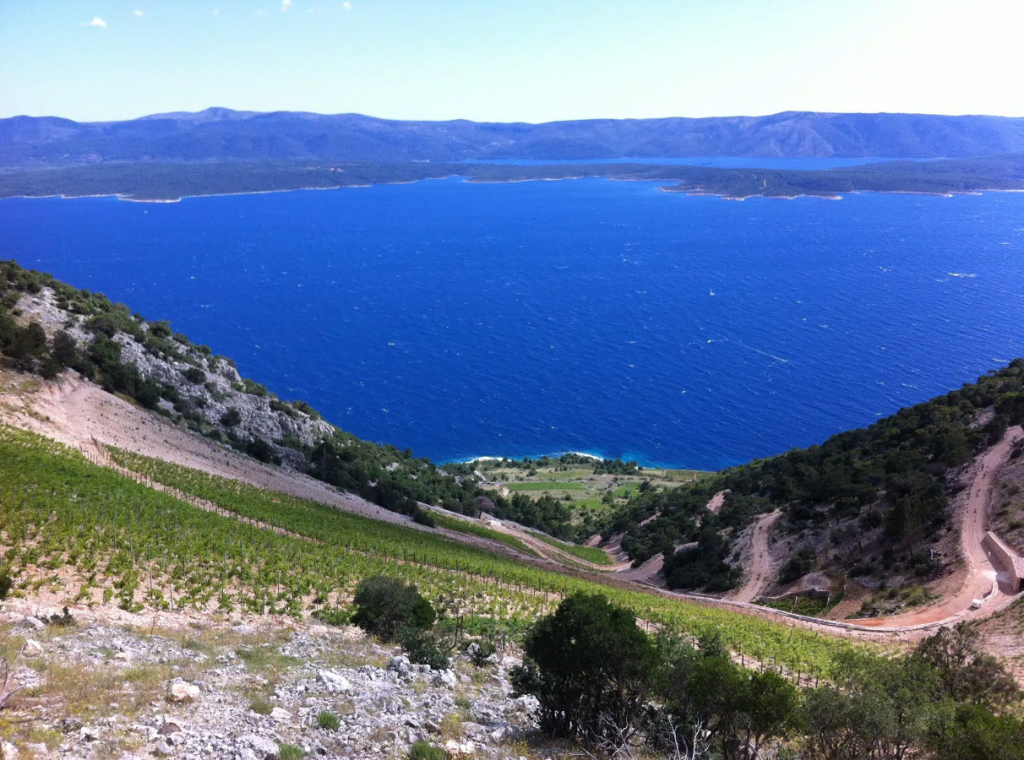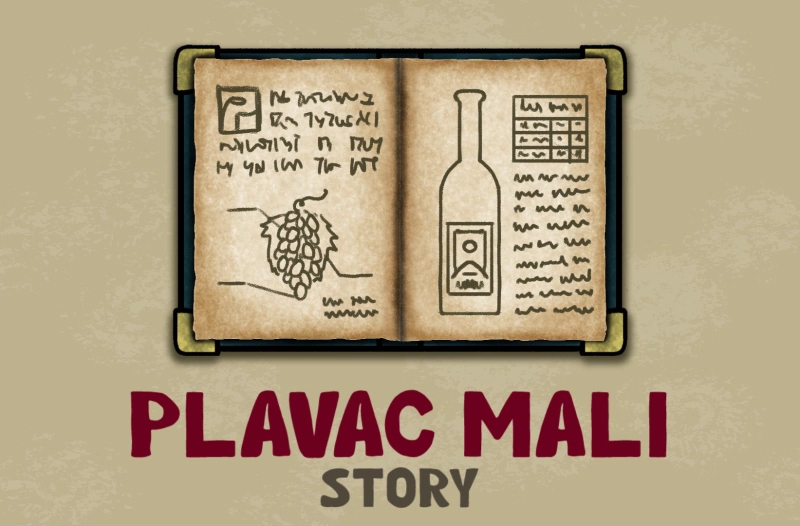13 May 2024 – On Croatia’s dazzling Dalmatian coast, basking in the sun, one grape stands out like royalty: Plavac Mali. It’s hailed as Croatia’s favorite red grape, dominating the country’s winemaking landscape. If you’re curious about Croatian wines and haven’t experienced them yet, come along as we and our friends from Wine&more explore the fascinating story of Plavac Mali, the most renowned native wine of Dalmatia!

Origins OF Plavac Mali
Plavac Mali is Croatia’s most widely grown red grape variety and a favorite in Dalmatian winemaking. The unique terroir of southern Croatia produces a range of indigenous red and white wines with distinct flavors and aromas. If you’ve ever sampled Croatian wine, chances are you’ve tasted Plavac Mali! Some of the country’s finest and most expensive wines are made from this grape.
The name “Plavac Mali” translates to “small blue,” perfectly describing the appearance of the grapes on the vine. Plavac Mali’s intriguing history has long fascinated wine experts. Its true origin was once a mystery, often mistaken for Zinfandel.
Interestingly, a Californian winemaker of Croatian descent, Mike Grgich, played a role in uncovering Plavac Mali’s connection to Zinfandel. He believed Zinfandel had Croatian roots and supported DNA research to prove it.
DNA analysis in 2000 confirmed that Plavac Mali’s “parents” are native Croatian varieties, Crljenjak Kaštelanski (the ancestor of Zinfandel) and Dobričić (an ancient red grape from Šolta Island).
characteristics of Plavac Mali
Plavac Mali, a late-ripening and low-yielding grape variety, showcases various styles influenced by winemaking techniques, terroir, and micro-locations. From approachable and fruit-forward to complex with aging potential, its wines offer a spectrum of flavors.
For example, renowned wine subregions like Dingač and Postup on the Pelješac peninsula and micro-locations on islands like Hvar, Brač, and Vis produce exceptional Plavac Mali wines with an aging potential of 20+ years.
Typically bold and flavorful with higher alcohol and tannins, Plavac Mali wines range from dry to semi-dry or sweet Prošek wines, a traditional Croatian dessert wine. Rich in dark berry aromas, these wines can also reveal notes of dried figs, carob, raisins, and sweet spices.
Oak-aged Plavac Mali wines have pronounced aromas of leather, cedar, baked fruit, and spices, with medium to full body, integrated tannins, moderate acidity, and a juicy, long-lasting finish.
Stina Winery, for instance, pioneers new methods to create vibrant, complex Plavac Mali wines from extreme single vineyards – such as Stipančić and Murvica. Here are some key characteristics associated with the Plavac Mali:
- Color: Plavac Mali wines typically exhibit a deep red to garnet hue, with most being opaque in the glass.
- Aroma: These wines offer a complex aromatic profile, evolving with each sip to reveal layers of dark fruits such as blackberries and plums, along with occasional hints of carobs, dried figs, or cherries. Mediterranean herbs like sage or thyme, as well as spicy and peppery notes, may also be detected.
- Body: High-quality Plavac Mali wines are known for their richness, full-bodied nature, boldness, and intensity, providing a substantial feel on the palate.
- Tannins: Tannins are integral to the varietal character of Plavac Mali, providing structure that can be quite firm. This characteristic aids in the wine’s aging process, allowing it to become smoother and more balanced over time. While aging in wooden barrels is common to soften the tannins, some exceptional examples are aged in stainless steel tanks.
- Alcohol Content: Thriving in Dalmatia’s rocky soils, Plavac Mali grapes naturally accumulate sugars, resulting in wines with a moderate (13.5%) to high (16%) alcohol content. This adds richness and warmth to the finish, although balancing alcohol levels poses a significant challenge in winemaking.
- Terroir Influence: Plavac Mali wines showcase distinct qualities influenced by the specific location where the grapes are grown. Subregions like Dingač and Postup on the Pelješac peninsula, as well as Komarna across the Pelješac Peninsula, are renowned for producing exceptional wines. Additionally, noteworthy micro-locations can be found on the islands of Hvar, Brač, and Vis.
- Lower Acidity: Plavac Mali grapes typically have lower acidity, enhancing the prominence of fruit flavors and giving the impression of sweetness, even in dry wines.
- Ageing Potential: Plavac Mali wines demonstrate the ability to mature and develop complexity over time. The finest examples shine after aging for 20+ years or even longer.
- Terroir Wines: Plavac Mali is noted for ripening unevenly unless grown in specific terroirs that produce exceptional wines. It’s not uncommon to find both unripe green berries and ripe raisins on the same grape cluster.
Terroir influence on Plavac Mali wines
Plavac Mali wines exemplify how the unique features of terroir and microclimate play a pivotal role in shaping both the grapes and the resulting wines.
Thriving in the hot and sunny Mediterranean climate, as well as in rocky and nutrient-poor soil, Plavac Mali grapes reach their full potential, especially on the sun-drenched southern slopes. Here, they produce full-bodied wines renowned for their exceptional quality and remarkable aging potential.
However, cultivating Plavac Mali can be a challenge if not done under optimal conditions. Its tendency to ripen unevenly is a well-known characteristic among winemakers.
When fully ripe, Plavac Mali grapes often have high levels of tannins and sugars but relatively low acidity. Achieving the perfect balance in Plavac Mali wines can thus be quite demanding for winemakers.
Exceptional terroirs highlight the distinctive traits of Plavac Mali. Traditionally, the most coveted vineyard sites for Plavac Mali were located on the southern, steep slopes of Dalmatian islands and the mainland.
Triple insolation Plavac Mali
Triple insolation is a term often linked with Plavac Mali, referring to the unique sun exposure it receives in sloped vineyards. This triple insolation involves:
- Maximum exposure to direct sunlight and sea breezes, intensified by limited rainfall.
- Sun rays reflected from the nearby coastline and vineyards on 45° inclined slopes.
- Additional light reflection from the white rock surfaces beneath the vines.
In essence, triple insulation means that Plavac grapes on the vine receive sunlight from three directions: directly, reflected from the white stone in the soil, and reflected from the sea.
However, with the increase in dry periods and climate change, this distinctive feature can sometimes become more of a challenge than an advantage. Some Plavac Mali wines may lack balance due to uneven or overripe grapes, along with low acidity, resulting in a somewhat muted flavor.
Nevertheless, different regions have their unique characteristics. For example, Plavac from the Komarna subregion is rarely overripe but tends to be highly concentrated and tannic, yet balanced. Similarly, Plavac Mali Stipančić from a single vineyard on Brač island shares similar traits.
Plavac Mali from Vis Island is notable for its ability to maintain balance even with higher alcohol levels. The sandy sediment in the topsoil and throughout the soil composition aids the Plavac Mali vines in achieving optimal ripeness.
So, if you encounter a bottle of Plavac Mali with 15% alcohol or more, don’t immediately assume it will taste too alcoholic. In fact, in the finest examples, you may not even notice the high alcohol content.
Where do the best Plavac Mali wines come from?

The best Plavac Mali wine subregions enjoy a typical Mediterranean climate: hot, dry summers with abundant sunshine and refreshing sea breezes.
The soil, rich in limestone and porous, efficiently absorbs rainfall, storing water deep underground where the vines’ extensive roots can reach, sometimes up to 10 meters deep.
These factors combine to create ideal conditions for Plavac Mali grapes to flourish. The most famous wine appellations known for outstanding Plavac Mali wines are:
- Dingač and Postup, Ponikve, Trstenik, and Mili on the Pelješac peninsula,
- Hvar Island, especially Ivan Dolac and Sveta Nedilja,
- Brač Island, especially Murvica and Stipančić,
- Komarna,
- and other distinctive subregions in Korčula and Vis Island, or
- Jadrtovac near Šibenik.
Plavac Mali from Pelješac Peninsula
The Pelješac Peninsula holds a special place in Croatia’s winemaking scene, particularly renowned as the “wine kingdom” of Plavac Mali. While white grape varieties also grow here, it’s the native Plavac Mali that truly shines, putting this region on the global wine map.
When it comes to red wines and Pelješac, Dingač is the first name that comes to mind among Croatians. Plavac Mali thrives in the extreme conditions of this rugged and wild seven-kilometer stretch of coastal land, making Dingač one of Croatia’s most unique appellations.
Exploring Dingač is a must for wine enthusiasts and anyone eager to experience one of the world’s most captivating vineyard landscapes. Dingač was the first wine appellation in the former state to receive geographical protection, way back in 1962.
Only wines made from grapes harvested from old bush-trained vines in this specific area can bear the Dingač label. Winemakers proudly uphold this distinction because Dingač wines enjoy worldwide renown, thanks to the favorable conditions that contribute to their exceptional quality.
Another renowned Plavac Mali cultivation area on the peninsula is Postup, the second Croatian wine appellation to receive state protection after Dingač, back in 1967. Other notable subregions in Pelješac include Ponikve, Trstenik, and Mili.
Family-owned wineries are gaining recognition in the global market for producing exceptional signature wines, with consumers increasingly favoring labels from these smaller producers. Pelješac’s wine kingdom has also attracted foreign investors, who now own some of the most esteemed wineries in the area.
Plavac Mali from Brač Island
Brač Island isn’t just famous for its stunning scenery and historic landmarks but also its vineyards and rich winemaking tradition. The island’s climate, soil, and local grape varieties all contribute to producing high-quality wines that are loved both locally and internationally.
In Bol, you’ll find the impressive Stina Winery, known for its exceptional Plavac Mali wines. The vineyards they source from are among the most extreme and picturesque in Croatia, meticulously restored to their former glory.
Stipančići and Murvica vineyards boast incredibly steep slopes, with Murvica standing out as the highest-altitude vineyard on the island. Harvesting on these steep slopes is a thrilling yet challenging experience, with workers fastening crates to themselves to prevent slipping.
Despite the daunting terrain, the extreme slopes and climate create the perfect conditions for Plavac Mali to thrive. Stina Winery offers three internationally acclaimed Plavac Mali labels, each providing a unique insight into Brač’s terroir:
Stina Plavac Mali Majstor: Harvested from the best positions for Plavac Mali around the village of Murvica, this wine boasts abundant red and black fruits, refined tannins, and a well-integrated wood influence from aging. It’s rich, with excellent aging potential, perfect for pairing with grilled meat or aged cheese.
Stina Plavac Mali Stipančić: A single-vineyard wine from Pustinja Stipančić, known for its steep slopes, southern exposure, and rocky soil. This wine is concentrated and fresh, with a rich bouquet of plums, Mediterranean scrub, and hints of smoke and leather. It pairs wonderfully with red meat dishes, mushrooms, truffles, and dark chocolates.
Stina Plavac Mali Remek djelo: Produced in exceptional years, this dry yet fruity wine is a true masterpiece. With only 350 bottles produced, it offers silky tannins, rich fruitiness, and elegant oak components. It’s full-bodied yet refined, perfect for special occasions.
Plavac Mali from Hvar Island
In Croatia’s sunny haven of Hvar Island, Plavac grapes enjoy a sun-drenched existence. Stretching along the coastline, vineyards absorb the radiant energy bouncing off the sea and rocky landscapes, infusing each grape with intense flavor.
Nestled along the Dalmatian coast, Hvar Island boasts not only beautiful beaches and vibrant nightlife but also lush lavender fields, olive groves, and vineyards. Hvar Island has a rich winemaking heritage dating back to the 4th century B.C., making viticulture an integral part of its cultural identity.
The Stari Grad Plain vineyards, a UNESCO World Heritage Site, stand as a testament to this legacy. These ancient plots, marked by dry-stone walls, reflect the ingenious land management techniques of Greek settlers, providing a glimpse into farming practices of ancient times while still remaining active today.
Plavac Mali reigns supreme here, constituting a whopping 70% of all plantings. Hvar Island is renowned for its extraordinary and diverse vineyards, spanning from famed appellations like Ivan Dolac and Milna to Sveta Nedjelja and Zavala. This picturesque region, where the Mediterranean sun and sea converge, yields exceptional wines worthy of celebration.
Plavac Mali from Vis Island
Vis Island stands out among the Dalmatian islands for several reasons. It’s not just its remote location that sets it apart, but also the scarcity of vineyards on its southern slopes overlooking the Adriatic Sea. Plavac Mali grown on Vis Island possesses a unique quality: it can handle high alcohol levels while still maintaining balance.
Several factors contribute to this beyond just cultivation techniques. The type of soil on Vis Island plays a crucial role in grape ripening. Compared to other regions where top-quality Plavac Mali is grown, the vineyards of Vis Island boast sandy soil. This sandy composition likely aids in achieving optimal grape ripening, resulting in well-balanced wines even with higher alcohol levels.
The majority of Vis Island’s vineyards are situated inland, amidst limestone fields, each imparting distinct characteristics to the grapes they nurture. Among the notable examples are the four different Vis Island Plavac Mali wines crafted by Vislander Winery.
Plavac Mali from Korčula Island
Korčula stands out among the Dalmatian islands for its unique characteristics. Covered with dense forests, it’s often referred to as the “black island.” Interestingly, Korčula is renowned for its white wines Pošip and Grk, a departure from the typical Plavac Mali domination in Dalmatian vineyards.
For example, Plavac Mali from Lumbarda is greatly different in style and character. It carried the same recognizable aromatic profile, only in a much thinner body. The tannins are also softer and the weight is supported by lively freshness, often a crucial issue for Plavac Mali.
Plavac Mali from Komarna
Komarna stands as Croatia’s youngest fully organic wine region. Situated opposite Pelješac, Komarna basks in a south-southwest orientation. Its vineyards sprawl across various altitudes, ranging from 250 meters to sea level, boasting an average slope of 30%, climbing up to 45% in select vineyards.
Benefiting from its close proximity to the sea and excellent aeration, Komarna offers an ideal setting for eco-conscious wine cultivation, requiring minimal protective measures. The microclimate is favorable, providing ample sunshine hours and a constant sea breeze, while the sun’s reflection off the sea and limestone surfaces enhances sun exposure.
Unlike Pelješac, Komarna experiences cool nights, allowing Plavac Mali wines from the region to retain remarkable freshness. When sampled, you’ll notice fewer jam and plum characteristics, yet the wines maintain concentration and power akin to those from the renowned Dingač and Postup appellations.
The Komarna area demonstrates that Plavac Mali can showcase diverse qualities while remaining consistently exceptional, authentic, and downright delightful.
Conclusion
Venturing into new wine territories? Exploring Croatian wines is an excellent choice, especially if you’re dipping your toes into the vibrant world of Croatian viticulture.
Plavac Mali, in particular, serves as an ideal introduction to the rich tapestry of Croatian wine. It’s a wonderful entry point that promises to unravel the intricate aromas and flavors characteristic of this indigenous Croatian red grape variety.
Prepare to be pleasantly surprised! Delving into the world of Plavac Mali will undoubtedly broaden your appreciation for Croatian wines, offering a fresh perspective and a newfound appreciation for the country’s vinicultural heritage.
NOTE: The article was originally written at wineandmore.com










